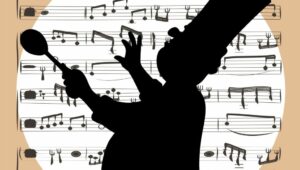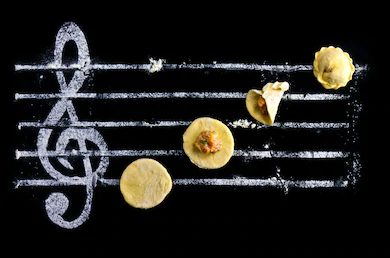
© rmillerdinnerparty.com
Being stuck at home during this Coronavirus Pandemic is not all bad. For one, it is returning something the modern world has brutally stolen from us; time!
We finally have enough time to leisurely read a book, watch a movie or extended serial, listen to music, or actually speak with relatives and friends. And there is one more thing I have rediscovered during this virus lockdown, and that is the delicious process of cooking food. Good food, like most quality things in life, simply can’t be rushed. If you’ve ever tried to hurry a Béarnaise, you know exactly what I am talking about. We know that cooking and music are essentially performing arts. So, pour yourself a glass of dry white wine and head for the kitchen. We’ve selected a couple of tracks to make your cooking and eating experience just a dash more flavorful. I know that Schubert was thinking about catching the fish, but his lovely Trout Quintet will provide you with plenty of inspiration to prepare a delectable fish dish.
Schubert: Piano Quintet in A Major, Op. 114, D. 667, “Die Forelle” (The Trout) (Anne-Sophie Mutter, violin; Hwayoon Lee, viola; Maximilian Hornung, cello; Roman Patkoló, double bass; Daniil Trifonov, piano)

© Shutterstock
Gioachino Rossini was a true food connoisseur, and during his time in Paris, chefs could not wait to invent new dishes for “The Maestro.” A dish à la Rossini had to contain three key ingredients; black truffles, foie gras, and Madeira wine. Some notable creations include “Stuffed Turkey à la Rossini,” “Fillet of Sole à la Rossini,” “Eggs à la Rossini,” and most famously, “Tournedos à la Rossini”. The name of the dish supposedly originated with the composer’s butler, who was obliged to “tourner le dos” (turn his back) on the diners to hide the secret final touches while carefully preparing the recipe under Rossini’s supervision. Lucky for you, on Interlude we never turn our backs on diners or listeners.
Gioachino Rossini: Peches de vieillesse, Vol. 4: Quatre hors d’oeuvres (Lorenzo Bavaj, piano)
Leó Weiner was born in Budapest in1885, and like most of his contemporaries he became a student of Hans von Koessler, who upheld the Brahmsian tradition of German Romanticism. In his symphonic poem Toldi—inspired by an emblematic masterpiece of Hungarian literature by János Arany—Weiner tells the story of a youth of great physical strength who sets out to reach the royal court. And attending an impressive culinary feast is clearly part of his heroic adventures.
Leó Weiner: Toldi Suite, Op. 43 – II. Vigasság, sütés-főzés Nagyfaluban (Making merry, cooking and baking in Nagyfalu) (North Hungarian Symphony Orchestra; László Kovács, cond.)

© Shutterstock
It’s not strictly about food, but Bach was supposedly rather fond of coffee. He was the director of the Collegium Musicum, which met in Leipzig on Friday evenings. If you have ever sat through late night rehearsals, you know exactly that a cup of Joe is one of the prerequisites for many musicians. The official title of his Coffee Cantata actually makes reference to the stimulating effects coffee can have on your nervous system.
Johann Sebastian Bach: Schweigt stille, plaudert nicht, BWV 211, “Coffee Cantata” (Emma Kirkby, soprano; Rogers Covey-Crump, tenor; David Thomas, bass; Academy of Ancient Music; Christopher Hogwood, cond.)
Erik Satie famously declared, “My only nourishment consists of food that is white: eggs, sugar, shredded bones, the fat of dead animals, veal, salt, coconuts, chicken cooked in white water, moldy fruit, rice, turnips, sausages in camphor, pastry, cheese (white varieties), cotton salad, and certain kinds of fish (without their skin). I boil my wine and drink it cold mixed with the juice of the Fuchsia. I have a good appetite, but never talk when eating for fear of strangling myself.” Not sure what kind of “white food” you are looking to prepare, but the score of Relâche might provide some inspiration.
Erik Satie: Relâche (Royal Philharmonic Orchestra; Philippe Entremont, cond.)
Maybe you are aware that baking is as much science as it is art. You’ve got to read through the recipe from start to finish so that you can prevent disastrous results. Of course, if you really want to experiment, regard your creation as an experiment, and expect a few failures along the way. I bet you can already tell how closely baking is related to musical performance. If you are ready to perform Camille Saint-Saëns’ “Wedding Cake,” better follow the recipe—oh sorry, the score.
Camille Saint-Saëns: Caprice-Valse Op. 76, “Wedding Cake” (Romain Descharmes, piano; Malmö Symphony Orchestra; Marc Soustrot, cond.)
For much of the 18th century, the “Divertimento” served as background music for social gatherings. It was intended purely for the enjoyment of the listeners and the players. Rather than engaging in a dramatic musical narrative or providing deep emotional contrasts, the Divertimento was expected to provide uncomplicated and unadulterated listening pleasure. Varying greatly with regard to the number of instruments and movements, I can’t think of better music to get your cooking pots humming.
Franz Joseph Haydn: Divertimento in F major, Hob. II:20 (Vienna Haydn Sinfonietta; Manfred Huss, cond.)
It is said that Antonio Vivaldi composed during meals. Given that he is the author of well over 500 concertos, he must have really enjoyed his dinners. Classical music and food share three very special aspects, namely tradition, regionality, and seasonality, which are continuously reinterpreted. Composing a work or creating a dish in the kitchen is a very similar process, as both try to connect with people. Luckily, Vivaldi had four seasons and specific ingredients at his disposal. Happy cooking and baking!


Bravo Janine, muy lindo! Felicitaciones a todo el grupo de músicos talentosos ❤️
Qué música tan maravillosa esta de Vivaldi. Hermosa e intensa.